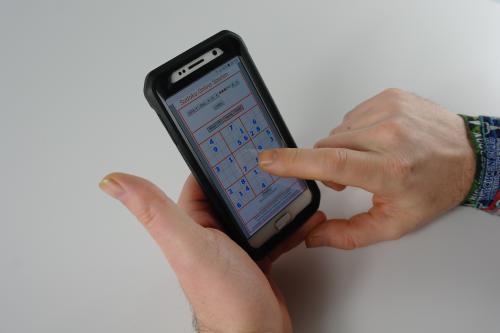Sudoku Online - Instructions for use ↥
The online Sudoku can be operated very simply using the mouse.
Select the date, number and difficulty and off you go!
Have fun solving the Sudoku!
Operating instructions for the online Sudoku ↥
By clicking in an empty Sudoku field, 9 small numbers appear.
These small numbers can be shown and hidden individually by a simple mouse click, so you can easily remember which numbers you have already excluded and which not. There are also 2 colors available for marking, whether you use both or not is up to you.
Double-click on a small number to enter it in the field. Clicking on an entered number takes you back to the small numbers.
After pressing the “Check” button, incorrectly entered numbers are displayed in red. Here, too, you can return to the help numbers by clicking on them.
Sudoku Online - Smartphone / Tablet ↥
On the smartphone or tablet, the auxiliary numbers are too small to switch them over, and in some cases it is not possible to double-click to enter the correct number. So there are additional buttons in “touchscreen” mode to operate the auxiliary numbers.
The additional buttons below the Sudoku field can be used to switch between the auxiliary numbers and also to enter a solution number. Click on a field to select it and then toggle the help numbers or enter the solution.

Sudoku online tools ↥
The “Scan everything” button scans the Sudoku for further solutions and displays them; solutions found can be entered by simply clicking on the corresponding field. If incorrect numbers have already been entered, the solutions found may of course also be incorrect.
The “Uncover” button is used to enter a correct number in a field. If a field is already selected in touchscreen mode, this will be used, otherwise you have to select a field after activating the button.
Sudoku Online in high contrast mode ↥
In addition to light and dark design, we also offer both in high contrast mode, i.e. pure black and white display. In this way, all forms of color blindness can be intercepted. Predefined numbers then have a continuous underline and incorrectly entered numbers have a dotted underline.
Sudoku competition ↥
As soon as a Sudoku has been solved correctly and also checked, you have the option of sharing the result on social media, then friends can also solve exactly this Sudoku and are shown the specified time and tools used and can also share it after solving to compare the results. Here are more details about the Sudoku Competition Mode.
Questions about Sudoku Online ↥
Is Sudoku Online free of charge? ↥
Yes, Sudoku Online is ad-financed, so there are no costs for the user. If you don’t want advertising, you can also use Sudoku via the Contentpass network.
Is Sudoku Online suitable for smartphones? ↥
Yes, there is a special mode for devices with touchscreens, where operation is via additional buttons and is quite intuitive.
Can I play Sudoku Online on my PC? ↥
Yes, the online Sudoku can be solved very comfortably on a PC, it can be operated purely with the mouse. Using the PC was also the original method of use, a mode for touchscreen was only added later.
What are the requirements for Sudoku Online? ↥
Sudoku Online only requires a current web browser with active Javascript, which is actually standard nowadays, and operation is purely by mouse or touchscreen.
Why play Sudoku online? ↥
Sudoku online is on the one hand resource-saving, no paper is needed that you throw away afterwards, on the other hand you have it quickly available nowadays, smartphone, tablet or PC and online connection are enough.
What do the Sudoku online statistics record? ↥
In the statistics for Sudoku online, below the number of solutions and the average time, only the solutions that were solved without aids and were checked once at the end are recorded.
Is Sudoku online good for the brain? ↥
Sudoku trains logical thinking and the ability to concentrate, keeping the brain fit. Sudoku is also ideal for quickly switching off from time to time, and especially online you have quick access to new Sudoku. Yes, online Sudoku is good for your mental health.
Sudoku as PDF ↥
It is also possible to download the printable Sudoku as a PDF and print it out. There are 24 Sudokus a day, each with 5 levels of difficulty, so 120 fresh Sudokus to print out every day.
The Sudokus in the PDF files are identical to the ones you can solve online here.
New partner site ↥
As the online sudoku was getting a bit long in the tooth, we decided to give it a complete overhaul. As the changes were more extensive than planned, we decided to test it on a new website first, and then in several languages. So you can now see and test the revised version of the online Sudoku webapp on Sudoku120.com: Sudoku Online.
( 824 Words = 5029 Characters)